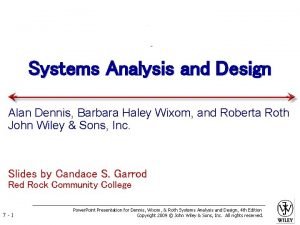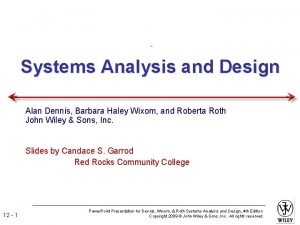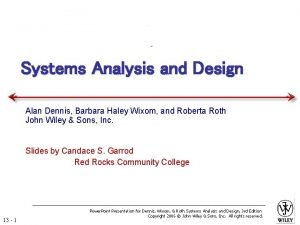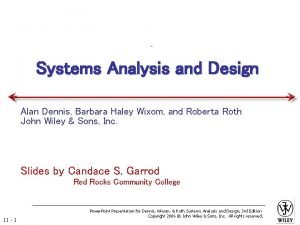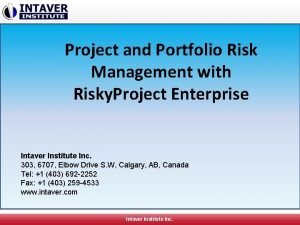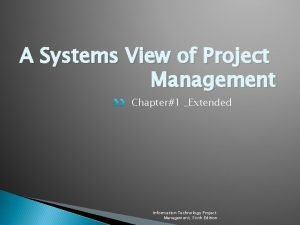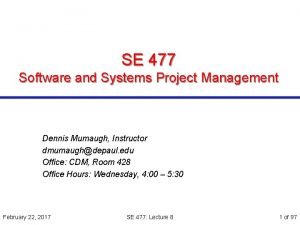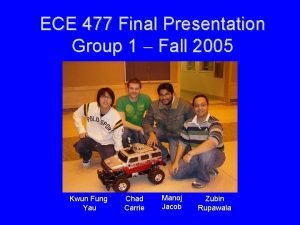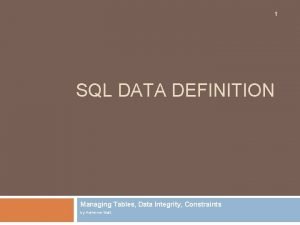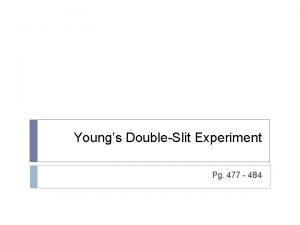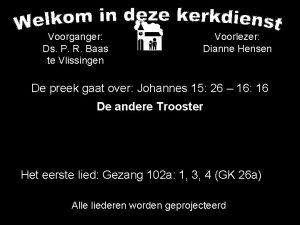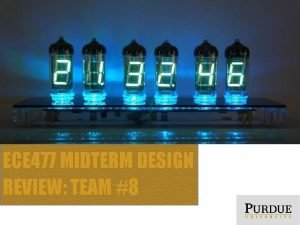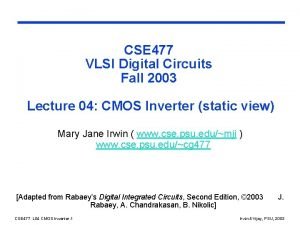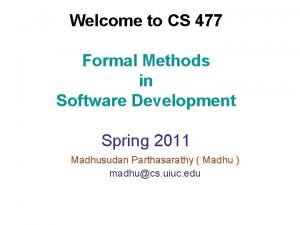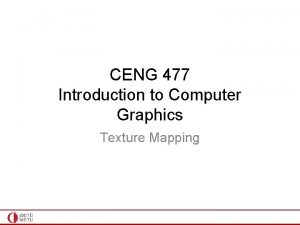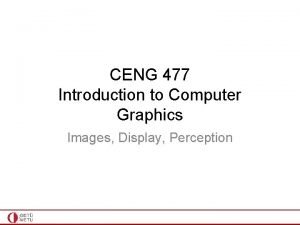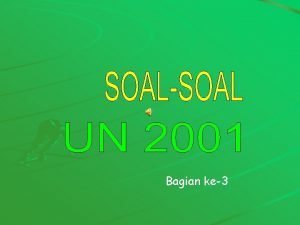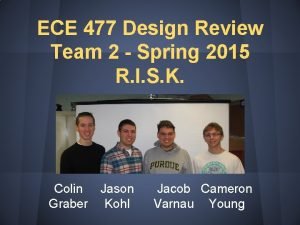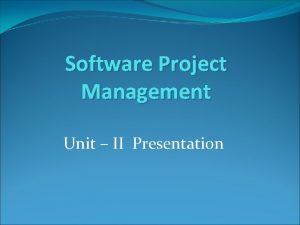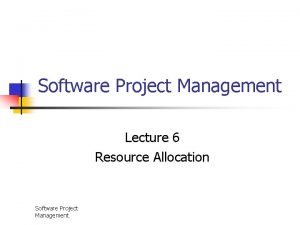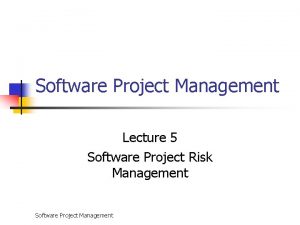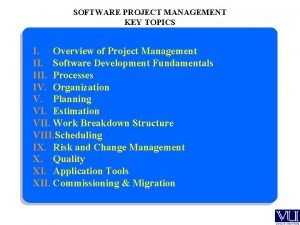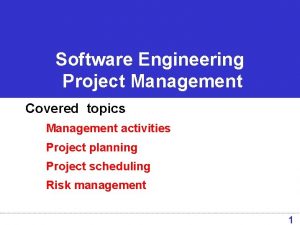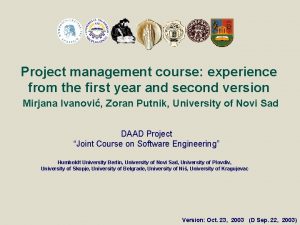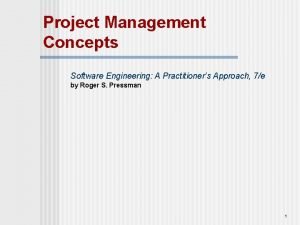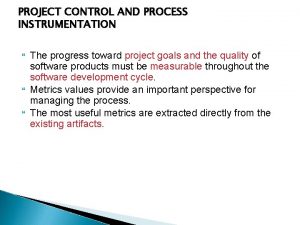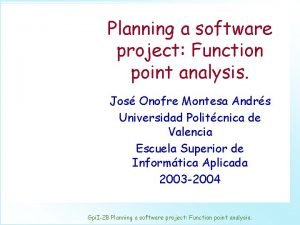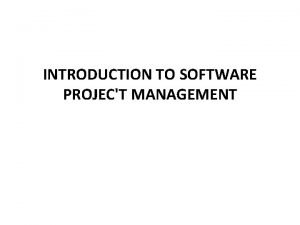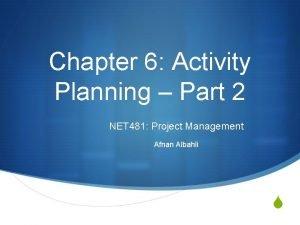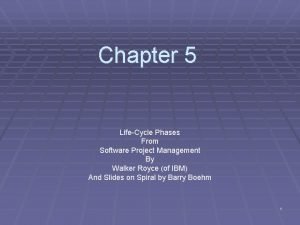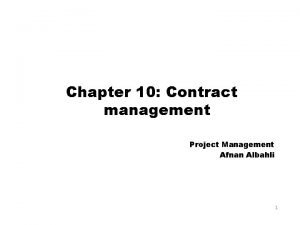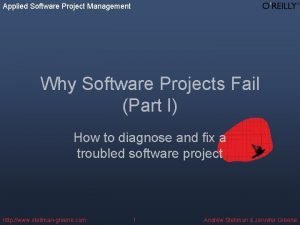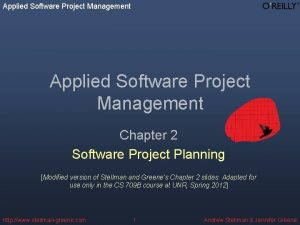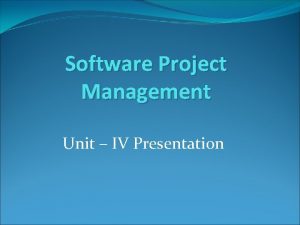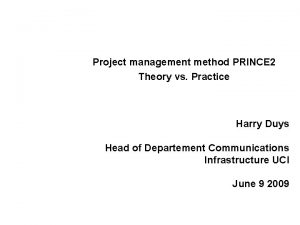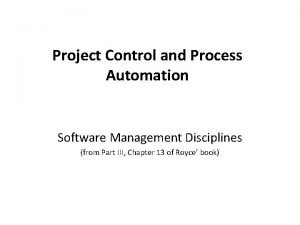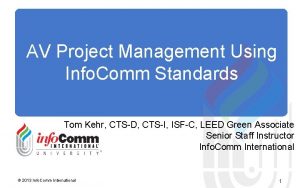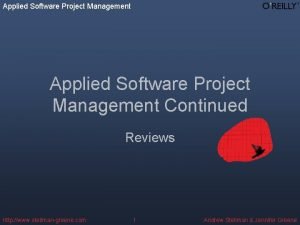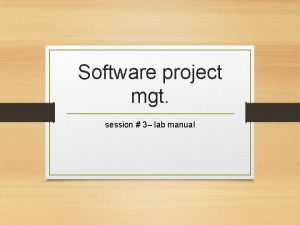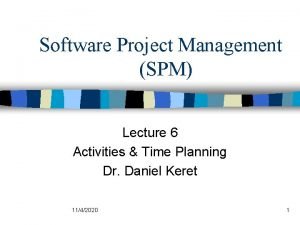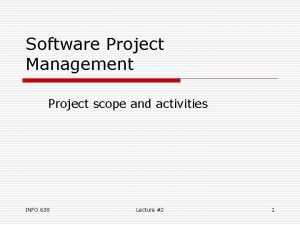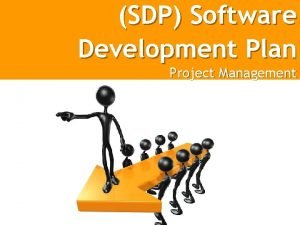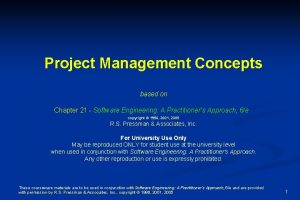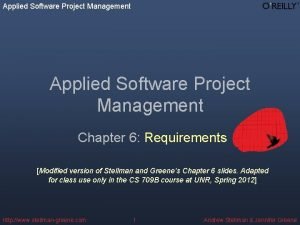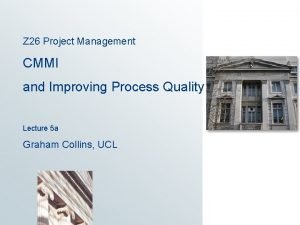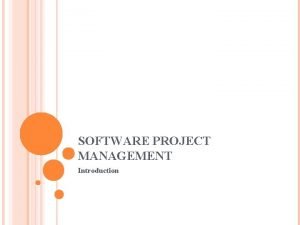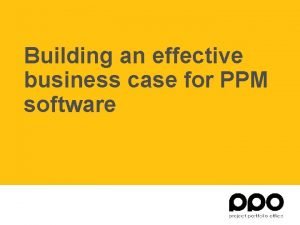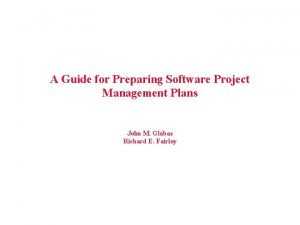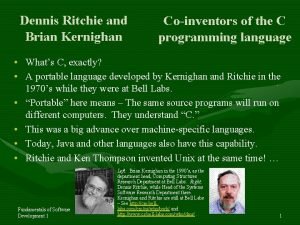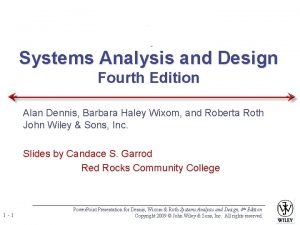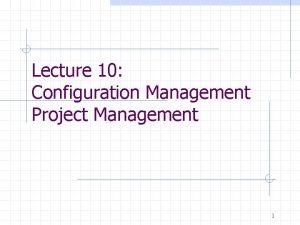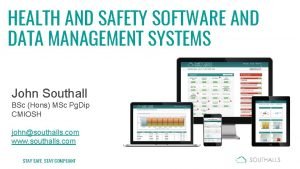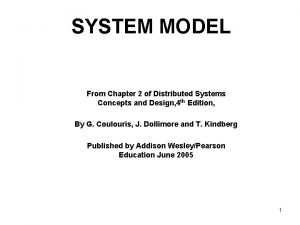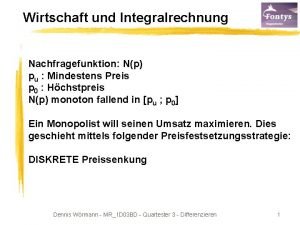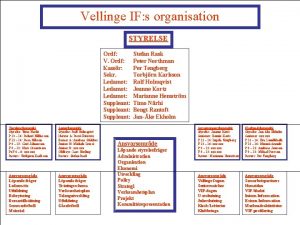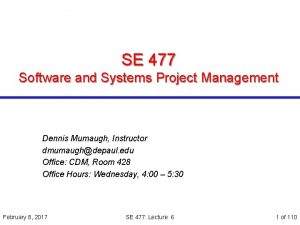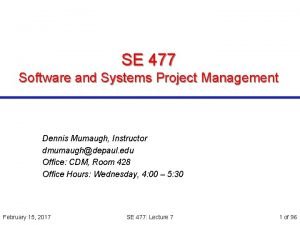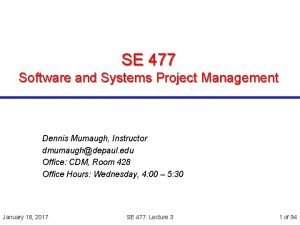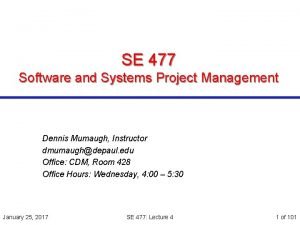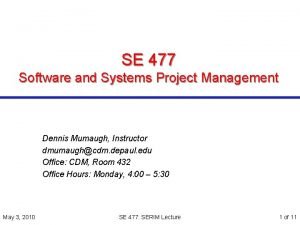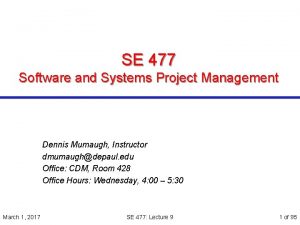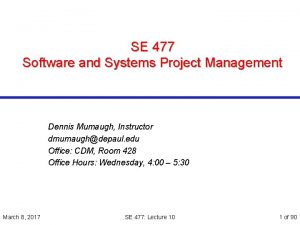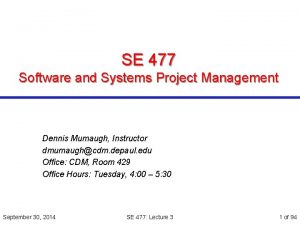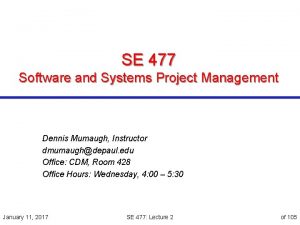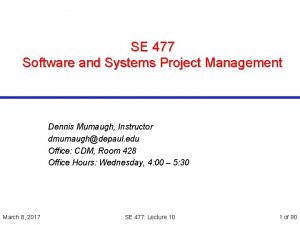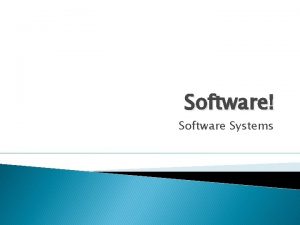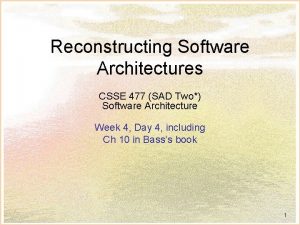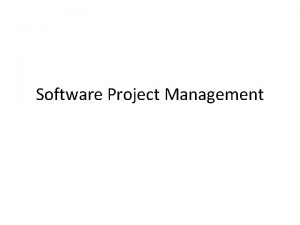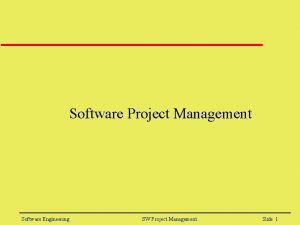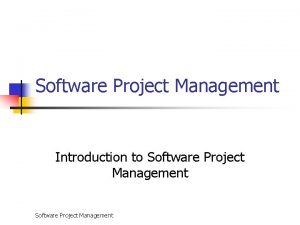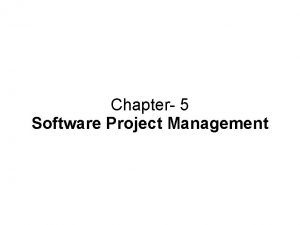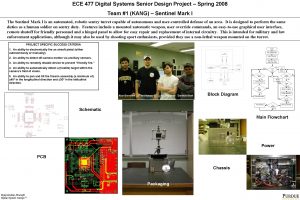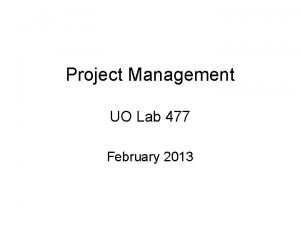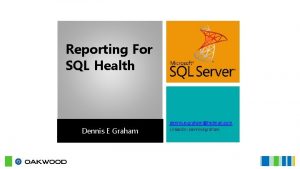SE 477 Software and Systems Project Management Dennis

































































































- Slides: 97

SE 477 Software and Systems Project Management Dennis Mumaugh, Instructor dmumaugh@depaul. edu Office: CDM, Room 428 Office Hours: Wednesday, 4: 00 – 5: 30 February 22, 2017 SE 477: Lecture 8 1 of 97

Administrivia § Comments and feedback Ø Lectures? Ø Work Load? Ø Reading? § Progress Ø Project Ø Journal Assignment 5 – Due March 8, 2017 Ø Monitoring and Control Ø No late submissions!! February 22, 2017 SE 477: Lecture 8 2 of 97

Midterm Exam Winter 2013 Spring 2013 100 99 Max Min 66 72 Fall 2013 99 67 Spring 2014 100 75 Fall 2014 100 82 Spring 2015 Winter 2017 99 100 60 71 Mean 89. 00 90. 40 86. 89 86. 69 90. 71 82. 80 88. 35 Median 90. 00 92. 00 86. 00 95. 00 87 90. 00 7. 48 11. 84 8. 26 90 Std. Dev. 9. 40 6. 53 9. 49 6. 94 Total 20 15 18 16 February 22, 2017 7 SE 477: Lecture 8 10 Grade distribution 90 -100 9 80 -89 6 70 -79 2 00 -69 0 17 3 of 97

SE 477 – Class 8 Topic: Miscellaneous: Ø Ø Quality control: planning and assessment and project tracking Configuration management and change control Stakeholder management; Final stages » Rollout » Migration » Project recovery Ø Defining project success and failure » Success tips § Reading: Ø PMBOK-SWE Ch. 4. 4, 4. 5, Ch. 8, Ch. 13 Ø See also reading list February 22, 2017 SE 477: Lecture 8 4 of 97

Thought for the day "I don't know the key to success but the key to failure is trying to please everybody. " – Bill Cosby February 22, 2017 SE 477: Lecture 8 5 of 97

Last time § Post-Planning Project Management aka Execution, Monitoring and Control, Project Closure § Project executing processes Ø Focusing on the project management process § Project Monitoring, Tracking and Control Ø Day-to-day tracking and management Ø Measuring software progress » Cost Schedule Control (aka Earned Value Analysis) Ø Milestones and status reporting February 22, 2017 SE 477: Lecture 8 6 of 97

Quality Control "Quality must be built in at the design stage. It may be too late once plans are on their way. " – W. Edwards Deming February 22, 2017 SE 477: Lecture 8 7 of 97

Perform quality control is concerned with monitoring specific project results for compliance with quality standards § Performed throughout project § May also include taking control actions to correct causes of quality problems Perform quality assurance is the process that provides the framework of activities and standards for performing quality control February 22, 2017 SE 477: Lecture 8 8 of 97

Role of the SQA Group – I Form a Software Quality Assurance Group § Prepares an SQA plan for a project. Ø The plan identifies » evaluations to be performed » audits and reviews to be performed » standards that are applicable to the project » procedures for error reporting and tracking » procedures for change management » documents to be produced by the SQA group » amount of feedback provided to the software project team § Participates in the development of the project’s software process description. Ø The SQA group reviews the process description for compliance with organizational policy, internal software standards, externally imposed standards (e. g. , ISO-9001), and other parts of the software project plan. February 22, 2017 SE 477: Lecture 8 9 of 97

Role of the SQA Group – II § Reviews software engineering activities to verify compliance with the defined software process. Ø identifies, documents, and tracks deviations from the process and verifies that corrections have been made. § Audits designated software work products to verify compliance with those defined as part of the software process. Ø reviews selected work products; identifies, documents, and tracks deviations; verifies that corrections have been made Ø periodically reports the results of its work to the project manager. § Ensures that deviations in software work and work products are documented and handled according to a documented procedure. § Records any noncompliance and reports to senior management. Ø Noncompliance items are tracked until they are resolved. February 22, 2017 SE 477: Lecture 8 10 of 97

Software Quality Assurance § The area of Software Quality Assurance can be broken down into a number of smaller areas such as Ø quality of planning, Ø formal technical reviews, Ø Testing and Ø training. § Here we take a look at Formal Technical Review methods and Testing. . . February 22, 2017 SE 477: Lecture 8 11 of 97

Formal Technical Reviews § Software quality assurance activity performed by software engineers to: Ø Uncover errors in function, logic, implementation. Ø Verify that the software meets requirements. Ø Represented using correct standards. Ø Achieve uniformity. Ø Manage projects. § Walkthroughs § Inspections (Code Reading) § Round-robin reviews [See notes and next slides for description/discussion of the above terms. ] February 22, 2017 SE 477: Lecture 8 12 of 97

Formal Technical Reviews § Walkthroughs Ø The least formal and most common kind of review is the walkthrough, which is any meeting at which two or more developers review technical work with the purpose of improving its quality. Ø Walkthroughs are useful to rapid development because you can use them to detect defects earlier than you can with testing. February 22, 2017 SE 477: Lecture 8 13 of 97

Formal Technical Reviews § Inspections and Code Reading Ø Code reading is a somewhat more formal review process than a walkthrough but nominally applies only to code. Ø In code reading, the author of the code hands out source listings to two or more reviewers. The reviewers read the code and report any errors to the code's author. February 22, 2017 SE 477: Lecture 8 14 of 97

Formal Technical Reviews § Inspections and Code Reading Ø Inspections are the most formal kind of technical review, and they have been found to be extremely effective in detecting defects throughout a project. Ø Developers are trained in the use of inspection techniques and play specific roles during the inspection process. 1. The "moderator” hands out the material to be inspected before the inspection meeting. 2. The "reviewers" examine the material before the meeting and use checklists to stimulate their reviews. 3. During the inspection meeting, the "author" paraphrases the material, the reviewers identify errors, and the "scribe" records the errors. 4. After the meeting, the moderator produces an inspection report that describes each defect and indicates what will be done about it. 5. Throughout the inspection process you gather data about defects, hours spent correcting defects, and hours spent on inspections so that you can analyze the effectiveness of your software-development process and improve it. February 22, 2017 SE 477: Lecture 8 15 of 97

Formal Technical Reviews § Round-robin reviews Each reviewer gets to present their comments on the product. The reviewers present one comment at a time. The person to the left of the leader starts, the reviewer to their left goes next, and so on, around the table (telephonic attendees are assigned an arbitrary order). § More discussion on Reviews: Round-Robin Review. Training Plan <http: //alumnus. caltech. edu/~leif/OO/Review. Training. html> February 22, 2017 SE 477: Lecture 8 16 of 97

“QA” & Testing § Testing “Phases” Ø Unit Ø Integration Ø System Ø User Acceptance Testing § Testing Types Ø Black-box Ø White-box February 22, 2017 § Static vs. Dynamic Testing § Automated Testing Ø Pros and cons § Defect tracking § Integration: 2 types Ø Top down Ø Bottom up SE 477: Lecture 8 17 of 97

Defect Rates § In general, defect rate is the number of defects over the opportunities for errors during a specified time frame § Defect rate found during formal machine testing is usually positively correlated with defect rate experienced in the field § Tracking defects and rates allow us to determine the quality of the product and how mature it is. February 22, 2017 SE 477: Lecture 8 18 of 97

Defect Metrics § Open Bugs (outstanding defects) § § Ø Ranked by severity Open Rates Ø How many new bugs over a period of time Close Rates Ø How many closed (fixed or resolved) over that same period Ø Ex: 10 bugs/day Change Rate Ø Number of times the same issue updated Fix Failed Counts Ø Fixes that didn’t really fix (still open) Ø One measure of “vibration” in project February 22, 2017 SE 477: Lecture 8 19 of 97

Defect Metrics § Why do we measure defects? Why do we track the defect count when monitoring the execution of software projects? What does this tell us? § Defect counts indicate how well the system is implemented and how effectively testing is finding defects. Ø Low defect counts may mean that testing is not uncovering defects. Ø Defect counts that continue to be high over time may indicate a larger problem, » inaccurate requirements, incomplete design and coding, premature testing, lack of application knowledge, or inadequately trained team. § Defect trends provide a basis for deciding on when testing has completed. When the number of defects found falls dramatically, given a constant level of testing, the product is becoming stable and moving to the next phase is feasible. Look at the next slide. § [See also notes. ] February 22, 2017 SE 477: Lecture 8 20 of 97

The Rayleigh Distribution Defect frequency If we graph defects over time they will show a Rayleigh distribution t e-t 2/2 k 2 Rc = k 2 k is a constant representing the time at which defects peak. Note the tail to the distribution. k We see this same curve in other areas as well. Specifically in reliability and quality. February 22, 2017 SE 477: Lecture 8 Time 21 of 97

Basic tools of quality § Cause-and-effect (fishbone, Ishikawa) diagram Ø Shows the relationship between the effects of problems and their causes Ø See lecture 6 slide 50 -52 and PMP Study Guide, p. 261 § Process flowcharts Ø Graphical representation of a project process that can help identify where problems occur Ø Example on lecture 6 slide 53 February 22, 2017 SE 477: Lecture 8 22 of 97

Basic tools of quality § Control chart Ø Maps the variation of a project variable (e. g. number of defects) as a function of time relative to a baseline value and within boundaries of ± 3σ » Baseline may be established after sufficient project variable data are available Ø Acceptable upper and lower boundaries of variable values are called the Upper Control Limit (UCL) and Lower Control Limit (LCL), respectively February 22, 2017 SE 477: Lecture 8 23 of 97

Basic tools of quality Control Chart Upper Control Limit +3σ Number of Defects +2σ +1σ Baseline value -1σ -2σ -3σ Baseline establishment February 22, 2017 Time SE 477: Lecture 8 Lower Control Limit 24 of 97

Histogram § A graphic representation of frequency counts of a sample or population § X-axis lists the unit intervals of a parameter like defect severity level and Y-axis contains frequency counts § Purpose is to show the distribution characteristics of the parameter February 22, 2017 SE 477: Lecture 8 25 of 97

Pareto Diagram § A frequency bar chart in descending order by types of problems or defects § X-axis is usually the defect cause and Y-axis is the defect count § Identifies the few causes that account for the majority of defects § Commonly see a 80 -20 pattern -- 80% of the defects from 20% of the causes February 22, 2017 SE 477: Lecture 8 26 of 97

Basic tools of quality 100 12 10 Number of Defects 6 4 2 8 6 50 % of Defects Number of Defects 75 4 25 2 Team A Team B Team C Histogram Team D Team C Team A Team B Team D Pareto Chart February 22, 2017 SE 477: Lecture 8 27 of 97

Run Charts § Tracks the performance of the parameter of interest over § § § time X-axis is time and Y-axis is the value of the parameter Best used for trend analysis Especially useful if historical data is available for comparisons with the current trend Frequently used for project management A run chart is a more general version of a control chart: it is mostly used for trend analysis rather than project control decisions. Look for patterns. February 22, 2017 SE 477: Lecture 8 28 of 97

Run Chart February 22, 2017 SE 477: Lecture 8 29 of 97

Scatter Diagram § Vividly portrays the relationship of two variables, if any. § For a cause-effect relationship, the X-axis is the independent variable § § § and the Y-axis is for the dependent variable Each point represents an observation of both variables x-y plot showing the relationship between two project variables Aid in looking for relationships between two variables A mathematical equation representing relationship between variables can be found using regression analysis (simple or multivariate) Scatter plots are useful for finding direct or indirect relationships which can then be used to analyze/improve quality. Correlation is not causation!! February 22, 2017 SE 477: Lecture 8 30 of 97

Project Duration Scatter Diagram February 22, 2017 SE 477: Lecture 8 31 of 97

Change Management "It is not necessary to change. Survival is not mandatory. " – W. Edwards Deming February 22, 2017 SE 477: Lecture 8 32 of 97

Integrated Change Control § Integrated Change Control is a project management integration knowledge area process concerned with project change requests § The Perform Integrated Change Control process is carried out from project inception through completion § All changes must be carefully controlled to maintain the integrity and consistency of the project plan Ø Change control encompasses review, evaluation, approval/rejection, and managing and coordinating approved changes February 22, 2017 SE 477: Lecture 8 33 of 97

Integrated change control § Recognizes that projects will often require changes to the established project plan § All changes must be carefully controlled to maintain the integrity and consistency of the project plan § Integrated change control encompasses all aspects of change to the project: Ø Reviewing and approving requested changes Ø Managing the changes when they actually occur Ø Controlling elements of the project management plan (scope, cost, budget, schedule, and quality) in response to changes Ø Controlling changes to requirements, design, code and documentation. February 22, 2017 SE 477: Lecture 8 34 of 97

Change or Configuration Control Configuration Management Plan § Change & Version control Ø Items: » Code (source for product) » Documents: requirements, design, test plans, user guides » Plans and data bases (MS project, etc. ) » Scripts for testing » Software development plan and other process documents February 22, 2017 SE 477: Lecture 8 35 of 97

Integrated Change Control § In some projects, the Integrated Change Control process includes a change control board (CCB) § The CCB is a formally chartered group responsible for reviewing, evaluating, approving, delaying, or rejecting changes to the project, and for recording and communicating such decisions § Note that changes have a potentially greater impact in CPM scheduling: Ø Changes on the critical path have greatest impact while those off the critical path have less § Changes in CCM scheduling require adjustments to buffers Ø The same responses to change are needed, but the impact to the schedule may be less severe than in CPM February 22, 2017 SE 477: Lecture 8 36 of 97

Change Control § Average project has 25% requirements change § Overly detailed specs. or prolonged requirements phase are not the answer § Sources of change § Change control is a process § Change Control Board (CCB) Ø Structure, process, triage February 22, 2017 SE 477: Lecture 8 37 of 97

Control the Change – I 1. Need for change is recognized 2. Change request is submitted as a “request for change” (RFC) or engineering change order (ECO) 3. Developer or PM team evaluates: impact and desirability 4. Change report is generated 5. Change control authority (CCB) makes a decision to either: a) Deny request. i. Change request is denied ii. User is informed b) Proceed February 22, 2017 If change is approved: 1. Request is queued for action. ECO (Engineering Change Order) is generated. 2. Individuals assigned to configuration objects. 3. Objects checked out and change made. 4. Change audited. 5. Baseline established. 6. If it is a Software Configuration Item (SCI) Ø Perform SQA and testing activities 7. Check-in the changed objects SE 477: Lecture 8 38 of 97

Control the Change – II For Software Configuration Items (SCI) 1. Promote SCI for inclusion in next release 2. Rebuild appropriate version a) Include all changes in release b) Review/audit the change c) Perform Verification and Validation [testing activities] 3. Distribute new version February 22, 2017 SE 477: Lecture 8 39 of 97

Control the Change – III q Use a change management system (COTS) and a change tracking system. q Ideal if they are integrated: aka Comprehensive Software Change Ideal if they are integrated: aka Management q SCM (Source code management) Ø Perforce – multi-platform client/server solution Ø Clear. Case (IBM/Rational) Ø Subversion Ø CVS q Issue/defect tracking software Ø Perforce – multi-platform client/server solution Ø Clear. Quest (IBM/Rational) offers comprehensive software change Clear. Quest (IBM/Rational) management February 22, 2017 SE 477: Lecture 8 40 of 97

Agile Perspective: Integrated Change Control February 22, 2017 SE 477: Lecture 8 41 of 97

Integrated change control § The agile change control process is not controlled by a change review board and the project manager Ø Product changes are owned and managed by the customer Ø Process changes are owned by the team Ø The project manager facilitates collaborative discussion of changes between the customer and the team ☛Integrated Change Control maps to ‘continuous backlog management’ in an agile project February 22, 2017 SE 477: Lecture 8 42 of 97

Summary comparison February 22, 2017 SE 477: Lecture 8 43 of 97

Stakeholder Management February 22, 2017 SE 477: Lecture 8 44 of 97

Introduction § Stakeholder Management is the process of developing appropriate management strategies for all project stakeholders § The process goal is to effectively engage stakeholders throughout the project life cycle § It analyzes their needs, interests, and potential impact on project success § The process provides a plan for interacting with project stakeholders with the project's interests as its goal February 22, 2017 SE 477: Lecture 8 45 of 97

Stakeholder Management Inputs § Project charter § Procurement documents § Enterprise environmental factors § Organizational process assets Tools & Techniques § Stakeholder analysis § Expert judgment § Meetings Outputs § Stakeholder register § Stakeholder management plan February 22, 2017 SE 477: Lecture 8 46 of 97

Stakeholder register § The stakeholder register is the primary output from the Identify Stakeholders process. For each stakeholder, the register contains: Ø Ø Ø Ø Ø Name Position in organization Location Role in project Contact information List of stakeholder’s major requirements List of stakeholder’s main expectations Potential influence on the project Phase in the lifecycle of most interest A stakeholder classification. This may include internal/external; supporter/neutral/resister; and high/medium/low influence/power/ impact/interest February 22, 2017 SE 477: Lecture 8 47 of 97

Stakeholders § Stakeholder engagement levels can be classified as: Ø Unaware of project and its potential impacts Ø Resistant. Aware of project and its potential impacts and resistant to the changes anticipated by the project Ø Neutral. Aware of project and neither supportive nor resistant Ø Supportive. Aware of project and its potential impacts and supportive of the changes anticipated by the project Ø Leading. Aware of project and its potential impacts and actively engaged in ensuring the project’s success February 22, 2017 SE 477: Lecture 8 48 of 97

Stakeholder management plan § The stakeholder management plan identifies the management strategies required to effectively engage stakeholders § The stakeholder management plan supplements the information in the stakeholder register with: Ø Desired and current engagement levels of key stakeholders Ø Scope and impact of change (due to project) to stakeholders Ø Identified interrelationships and potential overlap between stakeholders Ø Stakeholder communication requirements Ø Information to be distributed to stakeholders, including language, format, content, and level of detail February 22, 2017 SE 477: Lecture 8 49 of 97

Stakeholder management plan § The stakeholder management plan supplements the information in the stakeholder register with (cont’d): Ø Reason for the distribution of that information and the expected impact on stakeholder engagement Ø Time frame and frequency for the distribution of required information to stakeholders Ø Method for updating and refining the stakeholder management plan as the project progresses and develops § The stakeholder management plan contains sensitive information—appropriate precautions are needed to safeguard its information and prevent its inappropriate disclosure February 22, 2017 SE 477: Lecture 8 50 of 97

Stakeholder management plan Adapted from Figure 13 -6 PMBOK Guide, 5 th Edition February 22, 2017 SE 477: Lecture 8 51 of 97

Useful if conditions warrant § From the agile perspective, identifying stakeholders is a valuable process: the more inclusive your understanding of stakeholders, the better § Agile promotes the idea that transparency is the best policy Ø Agile utilizes information radiators: information tools (e. g. , a project wiki) that make project information—including progress and impediments—visible to all interested stakeholders Ø This minimizes the chances for miscommunication and effectively short-circuits the rumor mill February 22, 2017 SE 477: Lecture 8 52 of 97

Useful if conditions warrant § In some cases Stakeholder Management advocates tailoring information access and flow to the individual stakeholder § Though this approach may be warranted in some situations —volatile, highly-politicized project, for example—it is not without its risks: Ø “Project managers should be aware of the sensitive nature of the stakeholder management plan and take appropriate precautions. For example, information on stakeholders who are resistant to the project can be potentially damaging, and due consideration should be given regarding the distribution of such information. ”* § Analogies: Ø Private- vs. public-key encryption mechanisms Ø Proprietary vs. open-source software security *From Ch. 13. 2. 3. 1, PMBOK Guide, 5 th Edition February 22, 2017 SE 477: Lecture 8 53 of 97

Sidebar: Important stakeholders February 22, 2017 SE 477: Lecture 8 54 of 97

Software Project Management Final Stages February 22, 2017 SE 477: Lecture 8 55 of 97

Other Final Steps § Roll-Out Ø Release Check-List § Training Ø More than just end-users » Users, systems ops, maintenance developers, sales § Documentation » Many types: End-user, sales & marketing, operations, design § Migration Ø Moving users from existing system to your new one § Maintenance and Support We’ll discuss each of these … February 22, 2017 SE 477: Lecture 8 56 of 97

Rollout § Create a “Release Checklist” Ø Avoid activities falling through the cracks Ø Activities by Group: » Engineering, QA, Documentation, Operations Ø Possibly sign-off signatures § Roll-out: Must have a plan for the process Ø Often on a given day (ex: a Sat. ) Ø Must be a very detailed plan February 22, 2017 SE 477: Lecture 8 57 of 97

Shipping Details § § Packaging (if commercial product) Marketing collateral Security mechanisms (if commercial product) Licensing Ø Plan Ø Mechanism February 22, 2017 SE 477: Lecture 8 58 of 97

Installation § Scripts § Uninstall (if not Web-based) § If you need to install your software (as on PCs): Ø Don’t underestimate: » Time this takes to develop » Importance of a “first impression” § Or, if “custom” software you’re reselling Ø Installation at site is often a “mini-project” February 22, 2017 SE 477: Lecture 8 59 of 97

Training § Often more than just end-users Ø Users Ø Sales & Marketing staff Ø System operators Ø Maintenance engineers (possibly) Ø Sales engineers (possibly) Ø (Technical) Support staff February 22, 2017 SE 477: Lecture 8 60 of 97

Documentation § Must be ready by ship-date § Final user documentation Ø On-line help § Updates to other Ø Operations documentation Ø Development documentation Ø Sales and marketing material Ø Web site Ø Test reports Ø Release notes February 22, 2017 SE 477: Lecture 8 61 of 97

Migration is the process of moving from the old application/system to the new § Migration Plan § Back-out Plan § Data Conversion February 22, 2017 SE 477: Lecture 8 62 of 97

Migration Plan § Includes Ø Description of environment (computers, DBs, interfaces) Ø Description of existing data needed Ø Description of operational constraints (ex: when can we move to the new system? Weekends only? Last week of month only? ) Ø List of affected organizations and contacts Ø Plan of steps to be taken § Does it require a service interruption? Ø If so, when does this happen? A weekend? § Training? § Is there a help-desk? Ø If so, do they have “scripts” or new material? February 22, 2017 SE 477: Lecture 8 63 of 97

Migration Strategies § Communication with customers is crucial Ø Importance of 2 -way communication Ø What is happening, when, and why Ø “Why” should remind them of the benefits Ø Not too much detail or too little Ø Where do customers go for more information? § Minimize intrusiveness § Find-out about customer’s key dates Ø When does the system absolutely need to be stable? Ø Know about their important deadline dates Ø They must buy-into the approach! February 22, 2017 SE 477: Lecture 8 64 of 97

Migration Strategies § Considerations: Ø Level of business disruption Ø Degree of latitude in “production” date Ø How much internal opposition to system is there? » If higher, perhaps a longer ‘adjustment’ period Ø Your comfort level of system quality » If questionable, may want to mitigate risk February 22, 2017 SE 477: Lecture 8 65 of 97

Migration Strategies 1. Flash-Cut migration ☞ Straight-move from old system to new A. Immediate Replacement ØFastest approach ØStill want a back-out plan ØRequires strong planning and testing B. Parallel Operation ØMitigates risk ØParallel to either existing manual or system process ØCut occurs once new system “burned-in” 2. Staged migration ØReplace one part of existing system at a time February 22, 2017 SE 477: Lecture 8 66 of 97

Flash-Cut § Immediate Replacement Ø Ex: new corporate-wide calendar system § Requires very careful planning & testing § Still try to get some users to “try” it first if possible § Develop a back-out plan February 22, 2017 SE 477: Lecture 8 67 of 97

Cutover § § Criteria: What conditions must be met prior? Responsibility: Who decides? Operations: Who ‘owns’ it once it’s live? Rehearsals: Sometimes used. February 22, 2017 SE 477: Lecture 8 68 of 97

Back-Out Plan § Especially important for “conversions” § § Ø Customers already have expectations and needs as defined by their existing system Ø Must be able to restore customer’s service ASAP May mean running both simultaneously “just in case” Leave it in place for awhile (more than a day!) When to fall-back? Ø Mgmt: sooner, Tech: one-more-fix Ø Set a time limit (ex: 3 hours of start) Data recovery and migration back to old system February 22, 2017 SE 477: Lecture 8 69 of 97

Data Conversion § § Most systems need this step Most PMs forget this Impacts both completely new and replacement systems The “data” often more valuable than the “system” Data Conversion Areas § Data Sources: Ø Where does it come from? Ø Do you need to modify data on the way in? Ø Is it accurate? § Process Controls: Ø Does it happen all at once? Ø How do you guarantee it’s been done correctly? § Completion: Ø How do you handle any ‘exceptions’? Ø Do you make backups? Can you restart? February 22, 2017 SE 477: Lecture 8 70 of 97

Parallel Operation § Multiple variations of this method § An “adoption” period Ø See telephone industry with new area codes Ø Both work for a period of time § Strategies Ø Avoid flash-cuts if possible » Start with test subjects February 22, 2017 SE 477: Lecture 8 71 of 97

Concluding Software Projects § Seems simple, often isn’t § Potential Issues Ø Last-minute change requests » “One more feature” Ø Disputes of fulfillment of all requirements » Often “interpretation” issues Ø Keeping the team motivated Ø Difficult transition to maintenance February 22, 2017 SE 477: Lecture 8 72 of 97

Maintenance Phase § Need a support plan and a maintenance plan [should be part § § § of project plan] The “No respect” phase Less “glamorous” Ø Lack of enthusiasm Pressure to make fixes quickly Ø For “production” problems Software can become “hacked” “patchwork” over time Finding a support & test platform can be difficult Ø Often the forgotten child until fixes are needed February 22, 2017 SE 477: Lecture 8 73 of 97

Maintenance Phase § Compare to hardware maintenance Ø Not to keep state same; but changes to state Ø Fixes and enhancements § Configuration control is very important Ø Fixing the “right” version; tracking branches § Project management not always carried over § Smaller team Ø Often not a ‘dedicated team’ Ø Drawn from developers with other main tasks February 22, 2017 SE 477: Lecture 8 74 of 97

Maintenance Phase § Contracts, remember those? Ø Always consider the maintenance phase here Ø Often via a “labor hours” contract » Time & materials in a “direct” scenario Ø Otherwise via “maintenance contract” » Percentage of software license fee » Ex: 20% of original cost per year § Corp. budget if internal/IS projects Ø Often annual/monthly “maintenance” allocations February 22, 2017 SE 477: Lecture 8 75 of 97

Project in Trouble A student asked: “What if the project cannot meet the schedule? ” § Level with the sponsor § Move some features/requirements to a second phase § Use Resource Leveling Techniques Ø Ø Ø Fast tracking – two activities in parallel Activity shifting – Move start/end dates forward or backward Activity splitting – Break an activity into two or more pieces Activity stretching – Use less of a given resource continuously Resource substitution – Assign a different resource Allocating overtime – Work resources longer § Re-evaluate tasks: effort and need February 22, 2017 SE 477: Lecture 8 76 of 97

Project Recovery How to save a “drowning project” § 3 Approaches Ø Cut the size of the software Ø Increase process productivity Ø Slip the schedule, proceed with damage control § Opportunity for decisive leadership action § Not a time to ‘just cut corners’ Ø Be realistic (not foolish) § Timing: politically important Ø Not too early, not “too” late February 22, 2017 SE 477: Lecture 8 77 of 97

Project Recovery § First Steps Ø Assess situation » Is there a hard deadline, what’s negotiable, etc. Ø Don’t do what’s been done already Ø Ask team what needs to be done § People Steps Ø Morale; focus; re-assign » Restore morale • Sacrifice a sacred cow [See note] – Dress code, off-site, catered meals, etc. • Cleanup personnel problems » Focus people’s time • Remove non-essential work » Reassign tasks and responsibilities February 22, 2017 SE 477: Lecture 8 78 of 97

Project Recovery § Process Steps Ø Fix classic mistakes » Inadequate design, shortchanged activities, etc. ? Ø Create “Miniature Milestones” » Small (in day(s)), binary, exhaustive » Boosts morale: getting things done! Ø Track progress meticulously Ø Recalibrate after a short time Ø Manage risk painstakingly February 22, 2017 SE 477: Lecture 8 79 of 97

Project Recovery § Product Steps Ø Stabilize the requirements Ø Raise the bar on change requests Ø Trim the feature set (see feature set control) » Determine priorities, cut the low ones Ø “Take out the garbage” » Find error-prone modules; re-design Ø Get to a known, stable state & build from there February 22, 2017 SE 477: Lecture 8 80 of 97

Feature Set Control § § § Minimal Specification Requirements Scrubbing Versioned Development Effective Change Control Feature Cuts February 22, 2017 SE 477: Lecture 8 81 of 97

Software Project Management Project Success February 22, 2017 SE 477: Lecture 8 82 of 97

Think Small § § Keep requirements tight & focused One milestone at a time Smaller, incremental chunks As simple as possible but no simpler February 22, 2017 SE 477: Lecture 8 83 of 97

Process Spectrum Too much medicine can kill the patient Process Spectrum Chaos Bureaucracy Balance is crucial February 22, 2017 SE 477: Lecture 8 84 of 97

Miscellaneous You are not Santa Claus § Learn to say “No” Ø Be polite but firm § The Value of Versions Ø “We will put that in phase 2” § An Ounce of Prevention Paralysis § Analysis Paralysis Ø Over-process Ø Nothing gets finished Ø 65% of software professionals have experienced this § Paralysis Paranoia Ø Fear of over-process = process avoidance February 22, 2017 SE 477: Lecture 8 85 of 97

Miscellaneous § MBWA – Management by Walk About Ø Ø Shows you’re actually involved day-to-day Recognizes individuals may say more 1 -on-1 Allows spontaneity Finds personnel problems sooner § Delegate Ø Don’t be a “Control Freak” Ø You need to be the “hub” but not everything § Project Home Page Ø Give your project an intranet page Ø Central repository for project status, documents and other resources February 22, 2017 SE 477: Lecture 8 86 of 97

Success Metrics 1. On schedule v Requires good: plan; estimation; control 2. Within budget v Again: planning, estimation & control 3. According to requirements v Importance of good requirements v Perception & negotiation critical 4. High quality. May or may not be same as item 3 Only real measure: Is the customer happy? Customer satisfaction!! February 22, 2017 SE 477: Lecture 8 87 of 97

Success Rates § By Industry Ø Best: Retail » Tight cost controls in general Ø Worst: Government » Least controls § By Size Ø Smaller is better: cost, duration, team February 22, 2017 SE 477: Lecture 8 88 of 97

Why Do Projects Succeed? § How to identify a project’s success potential Ø What metrics could you look at? » Project size » Project duration » Project team size Ø Review assignment 1 February 22, 2017 SE 477: Lecture 8 89 of 97

Why Do Projects Succeed? § § § § § Executive support User involvement Experienced project manager Clear business objectives Minimized scope Standard software infrastructure Firm basic requirements Formal methodology Reliable estimates Standish Group “CHAOS 2001: A Recipe for Success” February 22, 2017 SE 477: Lecture 8 90 of 97

Why Executive Support? § Top management can help to: Ø Secure adequate resources Ø Get approval for unique project needs in a timely manner Ø Receive cooperation from people throughout the organization Ø Provide leadership guidance February 22, 2017 SE 477: Lecture 8 91 of 97

State of the Practice in Software Management § Factors that may influence the success or failure of the software projects could be: 1. Social Factors 2. Technology February 22, 2017 SE 477: Lecture 8 92 of 97

State of the Practice in Software Management Technologies on Unsuccessful Projects • No historical software measurement • • • Technologies on Successful Projects data Failure to use automated estimating tool Failure to use automated planning tool Failure to monitor progress or milestones Failure to use effective architecture Failure to use effective development methods Failure to use design reviews Failure to use code inspections Failure to include formal risk management Informal, inadequate testing Manual design and specification More than 30% creep in user requirements February 22, 2017 • • • • Accurate software measurement Early use of estimating tools Continuous use of planning tool Formal progress reporting Formal architecture planning Formal development methods Formal design reviews Formal code inspections Formal risk management Formal testing methods Automated design and specification Automated configuration control Less than 10% creep in requirements SE 477: Lecture 8 93 of 97

State of the Practice in Software Management Social Factors on Unsuccessful Projects • Excessive schedule pressure • Executive rejection of estimates • Severe friction with clients • Divisive corporate politics • Poor team communications • Naïve senior executives • Project management malpractice • Unqualified technical staff • Generalists used for critical tasks: quality assurance, testing, planning, estimating February 22, 2017 Social factors on Successful Projects • Realistic schedule pressure • Executive understanding of estimates • Cooperation with clients • Congruent management goals • Excellent team communications • Experienced senior executives • Capable Project management • Capable technical staff • Specialists used for critical tasks: quality assurance, testing, planning, estimating SE 477: Lecture 8 94 of 97

How to ensure a project fails § Do the same things you did on the last project. Over and over. § Don't listen to your experts. After all the last project worked out okay (mostly) § Don't measure progress with metrics. The only thing that counts is "did you meet the delivery date? ". § Set delivery dates with the customer but not with the developers. Developers can meet any schedule we ask for. § Don't use new tools. Keep using the ones we used ten, twenty years ago. § Spend your time making sure people do it your way. § Office politics and vendettas are more important than the project. February 22, 2017 SE 477: Lecture 8 95 of 97

Next Class Topic: Ø Miscellaneous: » Agile Project management » Project management anti-patterns; Reading: Ø See reading list February 22, 2017 SE 477: Lecture 8 96 of 97

Journal Exercises Choose one: 1. Thoughts on Post Project Reviews: do they really help, does an organization really learn from its mistakes? 2. Turnover and migration: horror stories and things that can go wrong 3. Support: just what is this about. More than help desks? February 22, 2017 SE 477: Lecture 8 97 of 97
 System analysis and design alan dennis
System analysis and design alan dennis Systems analysis and design alan dennis
Systems analysis and design alan dennis Systems analysis and design alan dennis
Systems analysis and design alan dennis Systems analysis and design alan dennis
Systems analysis and design alan dennis Systems analysis and design alan dennis
Systems analysis and design alan dennis Systems analysis and design alan dennis
Systems analysis and design alan dennis Systems analysis and design alan dennis
Systems analysis and design alan dennis Systems analysis and design alan dennis
Systems analysis and design alan dennis Systems analysis and design alan dennis
Systems analysis and design alan dennis Systems analysis and design alan dennis
Systems analysis and design alan dennis Systems analysis and design alan dennis
Systems analysis and design alan dennis Systems analysis and design alan dennis
Systems analysis and design alan dennis Iteration workflows in software project management
Iteration workflows in software project management Software project evaluation
Software project evaluation Improving software economics in software project management
Improving software economics in software project management Introduction for project
Introduction for project What is software configuration management
What is software configuration management Project indicator enables a software project manager to
Project indicator enables a software project manager to Project and portfolio risk management software
Project and portfolio risk management software A system view of project management
A system view of project management Ms project earned value management systems
Ms project earned value management systems Sw 477
Sw 477 Nilai dari alog 12 + alog 27 / a log 18 adalah
Nilai dari alog 12 + alog 27 / a log 18 adalah Sr0fx
Sr0fx Sepura *477
Sepura *477 Biba n 483 ddl
Biba n 483 ddl Experiment 484
Experiment 484 Liedboek 477
Liedboek 477 Ece 477
Ece 477 Cse 477
Cse 477 Cs 477 uiuc
Cs 477 uiuc Opwekking 477
Opwekking 477 Akar pangkat 2 dari 674
Akar pangkat 2 dari 674 Artinya
Artinya Ceng 477
Ceng 477 Ceng 477
Ceng 477 Jika log 2=0 301 nilai log 32 adalah
Jika log 2=0 301 nilai log 32 adalah Jika log 3=0 477 dan log 5=0 699 maka log 45 adalah
Jika log 3=0 477 dan log 5=0 699 maka log 45 adalah Ece 477
Ece 477 Ece 477
Ece 477 The role of project management in achieving project success
The role of project management in achieving project success Reducing project duration
Reducing project duration Introduction to project management kathy schwalbe
Introduction to project management kathy schwalbe Perpetual project closure
Perpetual project closure Agile ms project template
Agile ms project template Types of project termination in project management
Types of project termination in project management Effective software project management
Effective software project management Cash flow forecasting in software project management
Cash flow forecasting in software project management Allocation management software
Allocation management software Software project risk
Software project risk Software project management topics
Software project management topics Risk management activities in software engineering
Risk management activities in software engineering 4 p's of project management in software engineering
4 p's of project management in software engineering Project management tools in software engineering
Project management tools in software engineering 4 p's of project management in software engineering
4 p's of project management in software engineering Project control and process instrumentation in spm
Project control and process instrumentation in spm What is function point in software project management
What is function point in software project management Software
Software Engineering artifacts and pragmatic artifacts
Engineering artifacts and pragmatic artifacts Activity based approach in software project management
Activity based approach in software project management Life cycle phases in software project management
Life cycle phases in software project management Types of contract in spm
Types of contract in spm Applied software project management
Applied software project management Applied software project management
Applied software project management Forward pass definition project management
Forward pass definition project management Ball chart in spm
Ball chart in spm Activity based approach in software project management
Activity based approach in software project management Prince 1 project management
Prince 1 project management Seven core metrics in software project management
Seven core metrics in software project management Av project management software
Av project management software Applied software project management
Applied software project management Software project management lab manual
Software project management lab manual Spm software project management
Spm software project management Activities covered by software project management
Activities covered by software project management Top sdp plans
Top sdp plans 4 p's of project management in software engineering
4 p's of project management in software engineering Contoh wbs proyek aplikasi
Contoh wbs proyek aplikasi Class diagram of gym management system
Class diagram of gym management system Aon vs aoa
Aon vs aoa Project management software requirements checklist
Project management software requirements checklist Cmmi project management
Cmmi project management Software project objectives
Software project objectives Business case for a project portfolio management software
Business case for a project portfolio management software Project management software
Project management software Software project management plan spmp
Software project management plan spmp Brian kernighan y dennis ritchie
Brian kernighan y dennis ritchie System analysis and design alan dennis
System analysis and design alan dennis Decision support systems and intelligent systems
Decision support systems and intelligent systems Asset management vs project management
Asset management vs project management Configuration management in project management
Configuration management in project management Basic principles of cost management in project management
Basic principles of cost management in project management Project integration management
Project integration management Dss systems & software technologies ltd
Dss systems & software technologies ltd Systems integration plan
Systems integration plan Health and safety software systems
Health and safety software systems Software and hardware service layers in distributed systems
Software and hardware service layers in distributed systems Dennis wörmann
Dennis wörmann Dennis kortz
Dennis kortz








